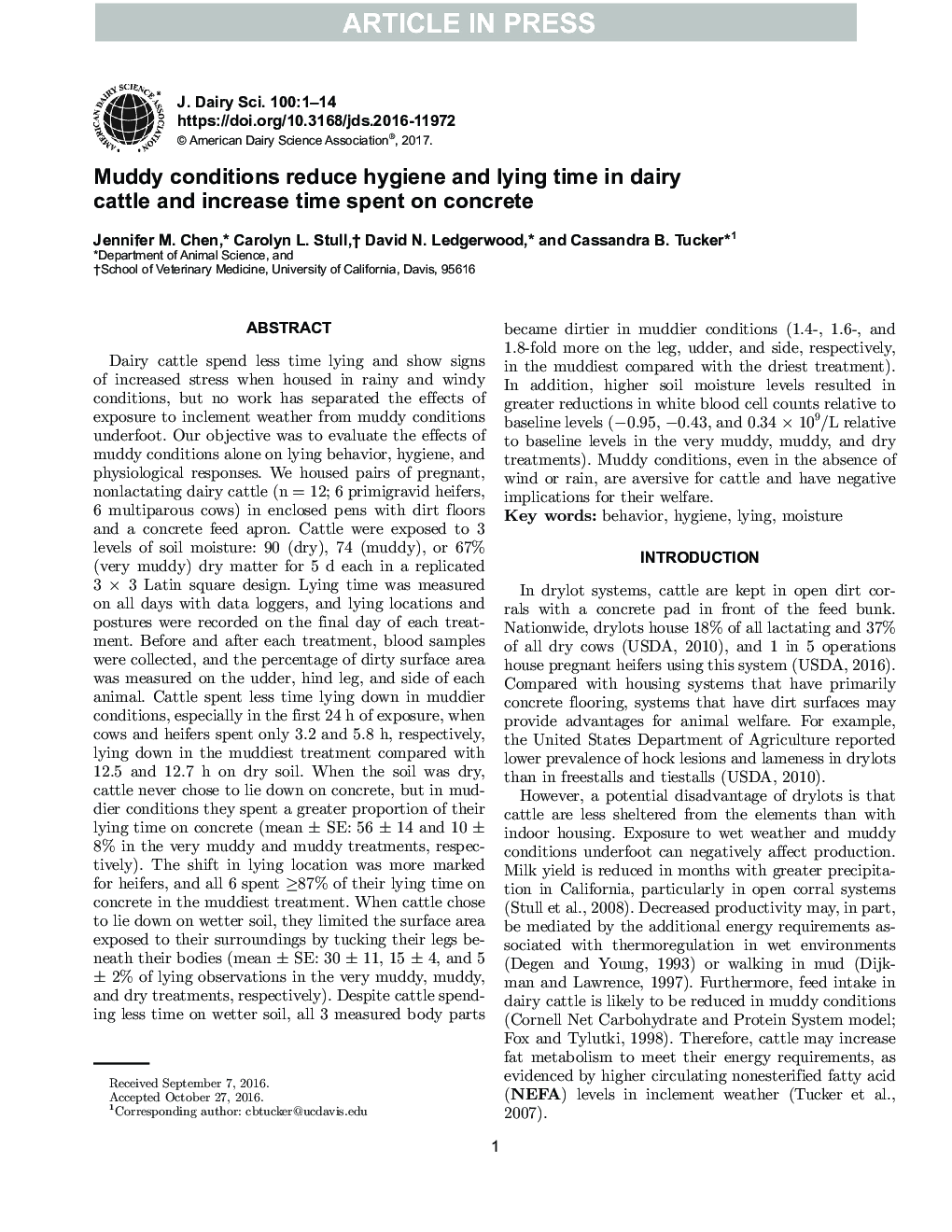| کد مقاله | کد نشریه | سال انتشار | مقاله انگلیسی | نسخه تمام متن |
|---|---|---|---|---|
| 5542512 | 1402519 | 2017 | 14 صفحه PDF | دانلود رایگان |
عنوان انگلیسی مقاله ISI
Muddy conditions reduce hygiene and lying time in dairy cattle and increase time spent on concrete
ترجمه فارسی عنوان
شرایط آب و هوایی باعث کاهش زمان بهداشت و دروغ در گاوهای شیری و افزایش زمان مصرف بتن می شود
دانلود مقاله + سفارش ترجمه
دانلود مقاله ISI انگلیسی
رایگان برای ایرانیان
کلمات کلیدی
رفتار - اخلاق، بهداشت دروغ گویی، مرطوب،
موضوعات مرتبط
علوم زیستی و بیوفناوری
علوم کشاورزی و بیولوژیک
علوم دامی و جانورشناسی
چکیده انگلیسی
Dairy cattle spend less time lying and show signs of increased stress when housed in rainy and windy conditions, but no work has separated the effects of exposure to inclement weather from muddy conditions underfoot. Our objective was to evaluate the effects of muddy conditions alone on lying behavior, hygiene, and physiological responses. We housed pairs of pregnant, nonlactating dairy cattle (n = 12; 6 primigravid heifers, 6 multiparous cows) in enclosed pens with dirt floors and a concrete feed apron. Cattle were exposed to 3 levels of soil moisture: 90 (dry), 74 (muddy), or 67% (very muddy) dry matter for 5 d each in a replicated 3 à 3 Latin square design. Lying time was measured on all days with data loggers, and lying locations and postures were recorded on the final day of each treatment. Before and after each treatment, blood samples were collected, and the percentage of dirty surface area was measured on the udder, hind leg, and side of each animal. Cattle spent less time lying down in muddier conditions, especially in the first 24 h of exposure, when cows and heifers spent only 3.2 and 5.8 h, respectively, lying down in the muddiest treatment compared with 12.5 and 12.7 h on dry soil. When the soil was dry, cattle never chose to lie down on concrete, but in muddier conditions they spent a greater proportion of their lying time on concrete (mean ± SE: 56 ± 14 and 10 ± 8% in the very muddy and muddy treatments, respectively). The shift in lying location was more marked for heifers, and all 6 spent â¥87% of their lying time on concrete in the muddiest treatment. When cattle chose to lie down on wetter soil, they limited the surface area exposed to their surroundings by tucking their legs beneath their bodies (mean ± SE: 30 ± 11, 15 ± 4, and 5 ± 2% of lying observations in the very muddy, muddy, and dry treatments, respectively). Despite cattle spending less time on wetter soil, all 3 measured body parts became dirtier in muddier conditions (1.4-, 1.6-, and 1.8-fold more on the leg, udder, and side, respectively, in the muddiest compared with the driest treatment). In addition, higher soil moisture levels resulted in greater reductions in white blood cell counts relative to baseline levels (â0.95, â0.43, and 0.34 à 109/L relative to baseline levels in the very muddy, muddy, and dry treatments). Muddy conditions, even in the absence of wind or rain, are aversive for cattle and have negative implications for their welfare.
ناشر
Database: Elsevier - ScienceDirect (ساینس دایرکت)
Journal: Journal of Dairy Science - Volume 100, Issue 3, March 2017, Pages 2090-2103
Journal: Journal of Dairy Science - Volume 100, Issue 3, March 2017, Pages 2090-2103
نویسندگان
Jennifer M. Chen, Carolyn L. Stull, David N. Ledgerwood, Cassandra B. Tucker,
